- Know about temples
India that the Marathas built or reconstructed across India. The
stability, safety, and peace that Marathas provided were instrumental in the
restoration of the freedom of worship during the 18th century.
Despite the
onslaught on Indian civilization, culture, and ethos by invaders starting the 8th
century, a major portion remained under the control of Hindu Kings. This
resulted, in a situation where the iconoclastic zeal of early and medieval
invaders was limited to a particular area. However, with the tentacles of
Mughal spreading far and wide, a situation arose whereby most areas esp. in Southern
and Eastern part of India which were previously untouched by the temple
destruction were now constantly under the threat.
The destruction of
temples and gurukuls by the invaders like Ghori, Ghazni, and Khilji was checked
by the later Hindu kings as places like Kashi and Somnath were destroyed and
rebuilt, multiple times. But year 1658 was momentous as Aurangzeb won the
four-way contest for the peacock throne and was crowned as the sixth Mughal
king. From 1658 till his death in 1707, Aurangzeb started industrious scale
destruction of temples and centers of learning. The name changes of various
towns and destruction were a part of a deliberate attempt to erase the Hindu
civilization.
Table
1: Sample list of towns where names were changed by Mughals.
|
Original Name
|
Changed Name
|
|
Nashik
|
Gulshanabad
|
|
Gorakhpur
|
Muazzambad
|
|
Pune
|
Muhiyabad
|
|
Mathura
|
Islamabad
|
|
Kashi
|
Muhammadabad
|
|
Patna
|
Azimabad
|
Even after
spending over 25 years in the Deccan Aurangzeb was unable to subdue the
Marathas but even in this situation the destruction of temples went on. The reconstructed
Somnath temple was again demolished in 1703-04. Similarly, the famous Vitthal
Mandir at Pandharpur was demolished by Aurangzeb as late as 1705.
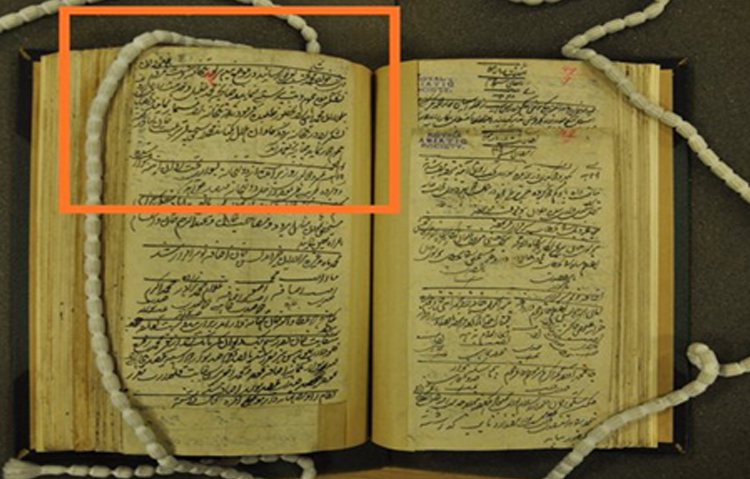 The original akhbar recording destruction of Vitthal Mandir by Aurangzeb. Pic by Manoj Dani.
The original akhbar recording destruction of Vitthal Mandir by Aurangzeb. Pic by Manoj Dani.
William Norris, the English ambassador to the court of Aurangzeb, had noted ruefully in his diary; “from Surat to this place (Parenda, Maharashtra), had seen hardly a temple of any consequence (i.e., big temple), and they (the people) seem to have forgotten when all the rest were destroyed. The Mughal (Aurangzeb) had taken great care, in all his conquests, not to leave the smallest trace of idolatry.
In the month of March, in the year 1706, he (Aurangzeb) withdrew to the city of Aurangabad (read: Ahmednagar), leaving behind him the fields of these provinces devoid of trees and bare of crops, their place being taken by the bones of men and beasts. Instead of verdure, all is blank and barren. The country is so entirely desolated and depopulated that neither fire nor light can be found in the course of three or four days of journey.”
This portrayal of
war-torn Deccan by Niccolao Manucci was in the early 18th century.
From the ashes of
the Deccan, the Marathas emerged like a phoenix, and within the next couple of
decades, the state started its journey towards an Empire which would bring
freedom including of worship. The best way to rekindle the freedom of worship
was to rebuild the places of worship and make them active again.
Temples and tirthas (pilgrimage sites) are not just
spiritual but have economic significance. Life in an Indian village still
revolves around temples, many times the whole economy of the village depends on
them. From the artisans and sculptors to those providing services to pilgrims,
everyone had a stake in it. The temple funds were used for charitable
activities like annadan, pathshalas, medical treatments for and the
needy etc.
Know about temples
reconstructed by the Marathas across India.
1. Shri
Mahalakshmi (Kolhapur)
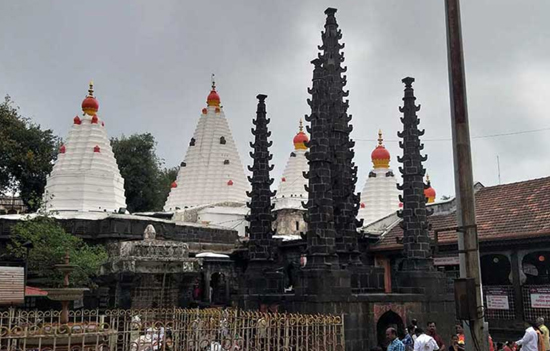
Karvir is a Shaktipeeth,
and abode of Mahalakshmi. The temple was patronized by successive dynasties
like Rashtrakutas, Kadamb, Shilahar, Western Chalukya, and Devgiri Yadav, but
during the Delhi and Deccan Sultanate period and also under Mughal occupation
the vigraha was kept hidden for
safekeeping.
The current temple
was inaugurated on Vijayadashmi of 1715 after Maharani Tarabai consolidated her rule and chose Kolhapur as a capital. “The triumphal re-entry of the great goddess into her own house marks the end of an era (of persecution/ temple destruction).” (Mate 48)
2. Shri Vitthal Mandir (Pandharpur) Pic credit Wikipedia
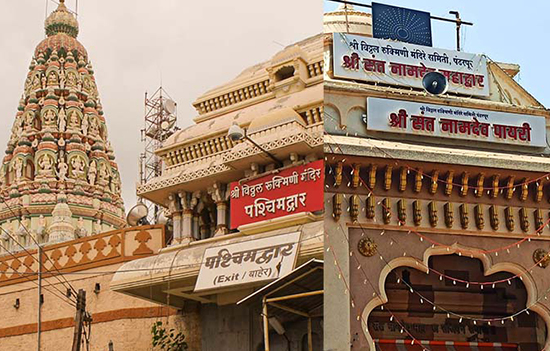
Like Karvir, Pandharpur
is also a very ancient pilgrimage site for devotees. Apart from the royal
dynasties of Maharashtra, dynasties like Hoysala and Vijayanagar were the
devotees of the Shri Vitthal. During the Deccan sultanate, this area was under
Adilshahi of Bijapur, hence Krishnadevaraya (Vijayanagar) who was a great
devotee was very worried about the safety of the temple and arranged to
transfer the vigraha of Shri Vitthal
to Vijayanagar but Bhanudas (grandfather of Sant Eknath) went to Vijayanagar
and convinced Krishndevraya to return the vigraha. (Mate 194-95)
Later when
Marathas started patronizing the temples, Pandharpur was also issued a royal
grant by Chhatrapati Rajaram. But as mentioned earlier, the temple was
demolished by Aurangzeb in 1705, however, the vigrahas were saved and when
Chhatrapati Shahu returned in 1707, the grant to the temple was renewed with
the reconstruction of the temple at the sacred site on the day of Vijayadashmi
in 1715. (Mate 197)
3. Trimbakeshwar
(near Nashik)
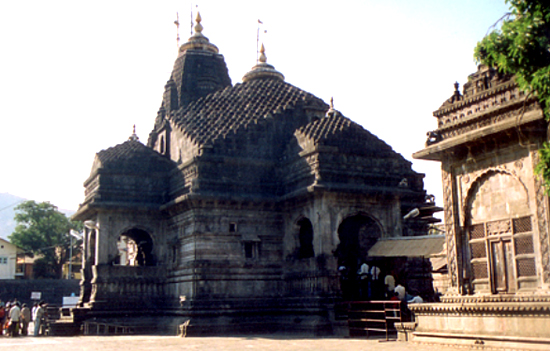
It is one of the
twelve jyotirlingas (sacred sites related to Shri Mahadev), the place where due
to tapobala (tapasya-penance) of
Gautama Rishi, Ganga herself had to come on earth according to temple tradition.
Chhatrapati Shivaji before proceeding towards Surat (end 1663), came here for
darshan. When the Mughals captured Nashik, the Mughal governor Bahadur Khan (foster
brother of Aurangzeb) was the one who demolished the beautiful temples in the
area.
When Marathas
liberated Nashik (early 18th Century), all the prominent temples like Sundar Narayan and some new temples were
rebuilt by various Maratha Noble families like Chandrachud, Rajebahadur and
Vinchurkar. The Trimbakeshwar temple was rebuilt in the same era by Peshwa
Balaji Bajirao alias Nanasaheb (Mate 143), while Kushavarta (also known as Tirtharaj,
where the Kumbh Mela happens) where Ganga (Godavari) emerges in a kund (pond)
was also rebuilt.
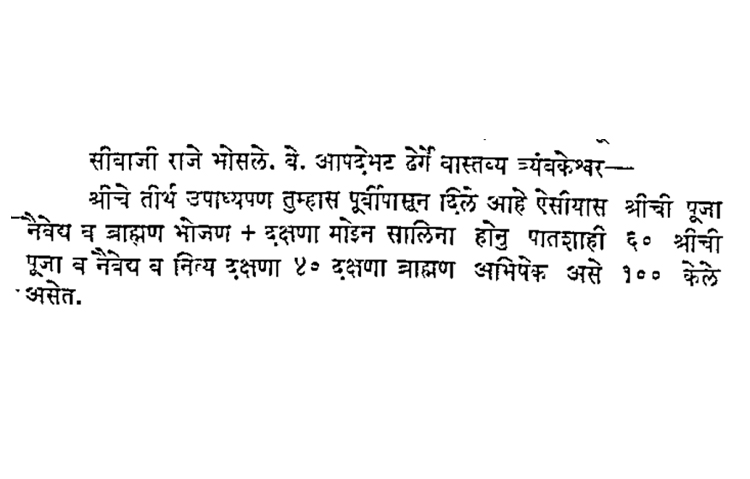
Letter of Chhatrapati Shivaji for an annual grant of Rs. 100 to Shri Dherge for Puja and Naivaidya (Tirthpurohit {Priest at that particular place} at Trimbakeshwar in 1670).
4. Saptakoteshwar
(Narve, Goa)
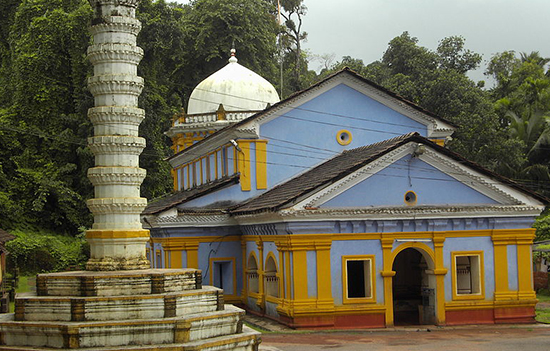 Pic courtesy Deboo.
Pic courtesy Deboo.
The Saptakoteshwar (Shiv) was the patron deity of Kadamba, the ruling dynasty of Goa. The title of King Jaikeshi was ‘Saptakotish-Labhdavar
Vir Jayakeshidev (By the grace of Saptakoteshwar).
(Purabhilekh Puratatva-V-2-Goa-108-09)
When the Bahamanis
attacked Goa, the temple was demolished but during the Vijayanagar era, it was
reconsecrated by Madhav Mantri at Diwadi.
During its occupation, the Portuguese launched a systematic drive to demolish the temples. The drive which started in 1540 went on till 1567 ‘till there was no temple to be seen’ as noted by Niccolao Lancillotto, an Italian Jesuit Priest. In this drive, Saptkoteshwar temple was again destroyed in 1540 by Minguel Vaz, a Portuguese priest, along with other temples (Pissurlencar 64) and the linga was deliberately placed as a well-shaft. However, the devotees managed to shift many of the deities including Saptakoteshwar to Bicholim and Ponda which were then not under Portuguese control.
The Saptakoteshwar
temple was built at Narve in Bhatagram (Bicholim) in 1668 when Chhatrapati
Shivaji liberated the region from Portuguese control. (GG-64)
5. Shri
Shantadurga & Shri Mangesh Temple (Goa)
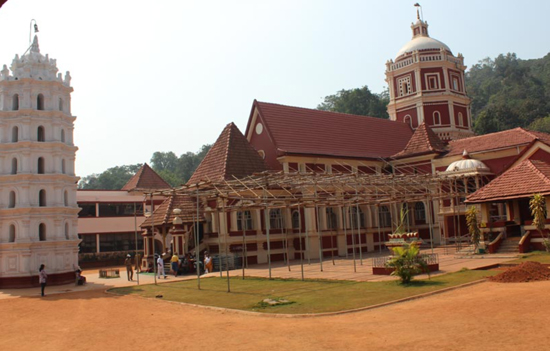 Shri Shantadurga, Kavale.
Shri Shantadurga, Kavale.
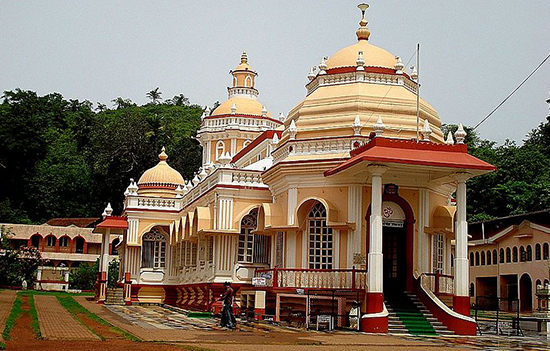 Shri Mangesh, Mangeshi. Pic credit Aruna at Malayalam Wikipedia.
Shri Mangesh, Mangeshi. Pic credit Aruna at Malayalam Wikipedia.
The temples of
Shri Shantadurga and Shri Mangesh are two of the most revered patron deities of
the Hindu Goud Saraswat Brahmin community. They are located in Kavle and
Mangeshi in the Ponda district of North Goa. The original place of Shree
Shantadurga Devi was Keloshi. From there Devi was shifted to Kavle during Portuguese
rule.
The current temple
of Shri Shantadurga was built during the reign of Chhatrapati Shahu by his
minister Naro Ram in 1720s, which was then expanded by Ramchandra Malhar in 1730s.
(Pissrulencar 168)
Similarly, the Shri
Mangesh temple was originally at Kushasthali (Cortalim) on the banks of River
Aghnashini (Zuari) but it was shifted to Priol by 1560s. The reconsecration
took place in 1740s again by Ramchandra Malhar.
Even though these areas came under Portuguese influence in the later part of 18th century, by that time their power and zeal for destruction and forced conversion were severely checked by the Marathas. Hence the temples not only survived but also flourished despite the regime change.
6. Ghrishneshwar
(Verul, Maharashtra)
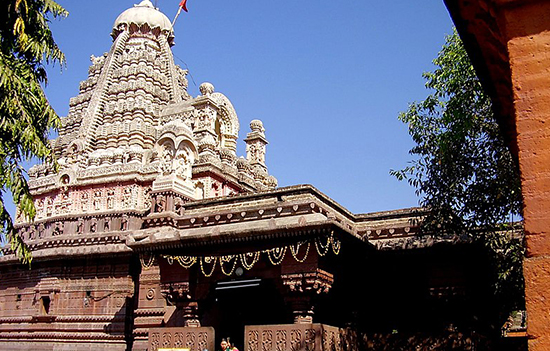 Pic credit Rashmi Parab.
Pic credit Rashmi Parab.
The Shiv Mandir at
Ghrishneshwar is a jyotirlinga and Kuldevta of the Bhosale family. During the
16th century, Maloji Raje and Vithoji Raje Bhosale reconstructed the earlier
temple. 75 bigha land was approved for building a garden (flowers for the
deity) as well as to construct a rest-house for the devotees. The grant was
renewed by Chhatrapati Shahu in 1720s. The temple was reconstructed again in
1730 by Gautamabai Holkar (wife of Malharrao Holkar) and Shivalay tirth, a tank
near the temple was renovated by Ahilyabai in 1769. (K.N.Sane- 126-27.
BISM-1838)
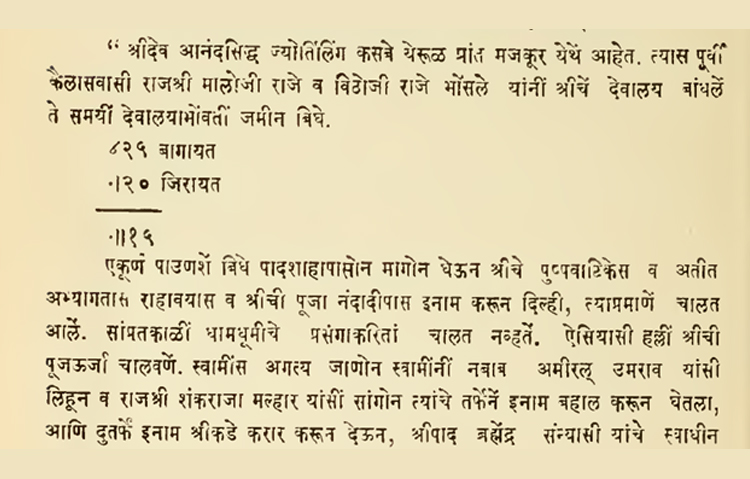
Translation: Renewal
of grant to Shri Ghrishneshwar Jyotirlinga at Verul (near Aurangabad) by
Chhatrapati Shahu which mentions the earlier temple was built by Maloji Raje
Bhosale (his ancestors)-Sanads Vad 106. (Author)
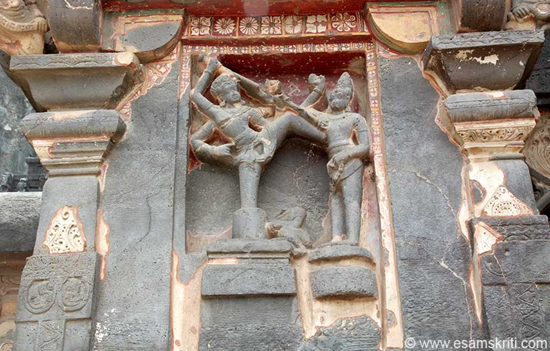 Kailasa Temple Ellora. The entire structure was given a lime wash and painted with ochre coloured paintings during the period of Ahilya Bai Holkar. See remains now.
Kailasa Temple Ellora. The entire structure was given a lime wash and painted with ochre coloured paintings during the period of Ahilya Bai Holkar. See remains now.
Also
read
Details
of Temple renovation and building by Ahilyabai Holkar And
The
Maratha Complex at Ellora
7. Shri
Mahakaleshwar (Ujjain)
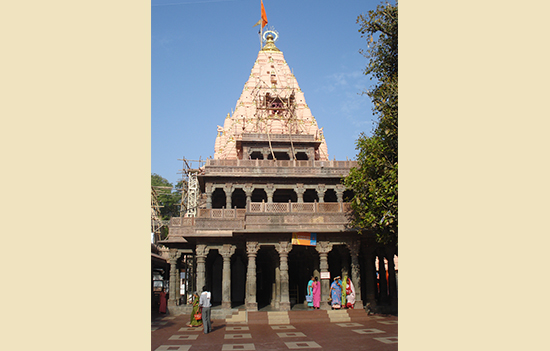 Pic credit Wikimedia commons.
Pic credit Wikimedia commons.
Ujjain or ancient
Avanti was a city that was mentioned in the Ramayana. One of the seven holy
pilgrimage sites, the city was called a navel of the earth as it is situated on
the intersection point of the Prime Meridian and the Tropic of Cancer. Before
Europeans started calculating the Prime Meridian from Greenwich, Indian
astronomers had based their calculations on Ujjain as Prime Meridian. (Dongray
112). Mahakaleshwar (which can mean either the God of time or death which again
signifies the connection of the city with astronomy), one of the 12
jyotirlingas is located here.
To
see albums of Ujjain City
and Jantar
Mantar Observatory
The temple was first destroyed by Sultan Iltutmish in 1234-35 but it seems that a makeshift temple was built for Mahakaleshwar as various medieval records show. It was visited by Chhatrapati Shahu after his release from the Mughal camp by Azam in 1707 (Burway 46). In the 1730s, when Malwa was liberated from Mughals, the area of Ujjain was given to Ranoji Shinde as a fief (jagir). Ramchandra Malhar, who was then Diwan of Shinde’s reconstructed the current temple of Mahakaleshwar as well as other temples which were earlier destroyed and lying in dilapidated condition in and around Ujjain. (Dongray 39-40)
8. Shri
Jagannathpuri (Orissa) & Surya Mandir (Konark)
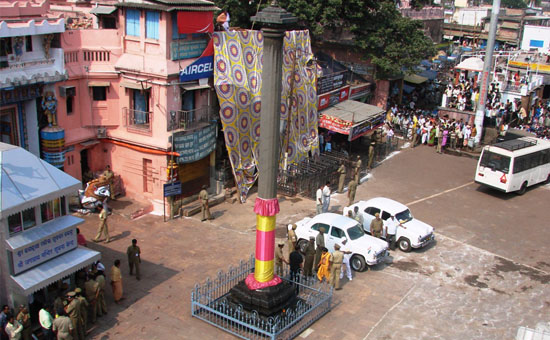 Arun Stambha at Jagannath Sinh dwar. Shifted from Konarak to Puri during Maratha rule. Pic Rabi Sahoo.
Arun Stambha at Jagannath Sinh dwar. Shifted from Konarak to Puri during Maratha rule. Pic Rabi Sahoo.
Though Aurangzeb
had ordered the destruction of Shri Jagannath, the bribing of key Mughal
officers like Mughal Commander by Divyasimha Deva (Raja of Khurda), ensured the
survival of the temple. However, the archakas
had to close the temple for devotees and stop the rathyatra to maintain this
charade. The threat remained, even after the death of Aurangzeb, from the Bengal
Nawab.
This situation
changed in 1740 when Maratha forces of Senasaheb Subha Raghuji Bhosle made
Orissa an operational base for an attack on Bengal. By 1751, Aliwardi Khan ceded
Orissa completely to the Marathas.
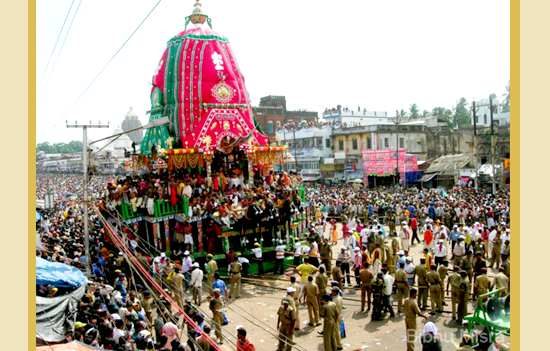 Puri Rath Yatra resumed during Maratha rule. Pic by Bibhu Mishra.
Puri Rath Yatra resumed during Maratha rule. Pic by Bibhu Mishra.
The Maratha
domination of Orissa was key to revival of the Shri Jagannath yatra, as due to security and peace in the region
devotees were able to resume their worship. Marathas took active role in temple
management, safety of pilgrims, and providing necessary facilities during the
journey so once again devotees from as far as Rajasthan and Gujarat came to
Puri. A sum of Rs 6,000 was spent annually on Anna Chhatra for the devotees. Similarly, Raghuji Bhosale donated Satais Hazari Mahal (area with annual
revenue of Rs. 27,000) for day-to-day expenditure of Shri Jagannath. (P.M.Barik-78)
Surya Mandir of Konark, one of India’s finest architectural marvels was built by Gajapati Narasinh Dev in the 13th Century. Abul Fazl, had also described the temple in 16th Century. However, without active worship the temple faded from memory in the 17th and early 18th centuries. It was completely deserted till Shivbhat Sathe, the Maratha Subhedar of Orissa (1760-64) found it and brought it again in front of the world.
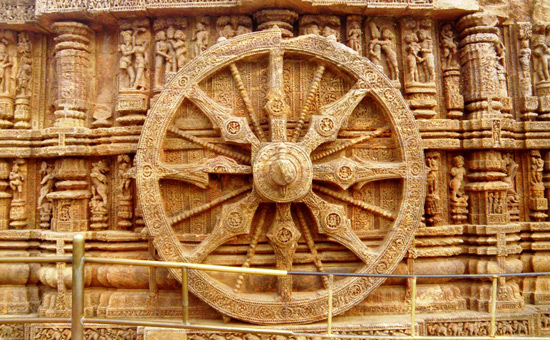 Sun Temple Konarak was discovered by Maratha Subhedar of Orissa (1760-64).
Sun Temple Konarak was discovered by Maratha Subhedar of Orissa (1760-64).
The Arun Stambha (Arun-Charioteer
of Surya), which was originally from Konark was brought and placed in front of
Shri Jagannath temple in 1770s under the directions of Brahmachari Gossain
(Maharashtrian ascetic), the Rajguru of Divyasingh Deva.
Also
read
When
Lord Jagannath witnessed great Maratha devotion
9.
Shri Somnath (Gujarat)
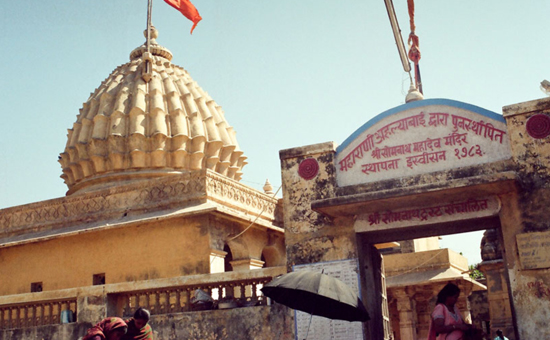
Freedom fighter and author Kulapati K.M.Munshi wrote, “An ancient race subconsciously felt that, it was Somanatha which connected it with the past and the present; it was the eternal symbol of its faith in itself and its future. As often as the shrine was destroyed, the urge to restore if sprang up more vividly its heart.” Somnath, The shrine eternal. (Pg 83, 84)
The temple of
Somnath, one of the twelve Jyotirlingas of Mahadev was present from antiquity
as we can find it in Mahabharata where Somnath was already a well-known tirtha (pilgrimage place). At the behest of or by Mahmud Ghazni (1025-26), Khiljis and the Sultanate of Gujarat the temple was demolished multiple times. Finally, during the reign of Aurangzeb the temple was demolished in 1660s and again in 1703-04 in such a way that “there may not remain any vestige of the building, and devotees should be expelled.”
After Gujarat was
liberated from the Mughals by the Marathas in the 1750s, the situation
stabilized and the temple for Shri Somnath was restored in 1783 by Maharani
Ahilyabai Holkar (Somnath-83). This temple was for the devotees of Somnatha
till a new temple was built in 1950 by the efforts of K.M. Munshi and Sardar
Patel.
10. Shri
Kashi Vishwanath
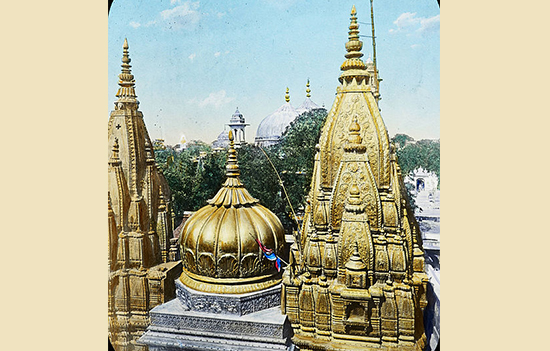 Credit Wikipediacommons.
Credit Wikipediacommons.
Kashi (Varanasi/Benaras)
is the holiest city of Hindus, the abode of Lord Shiv, the city of moksha, and
one of the continuously inhabited cities known to mankind. For this exact
reason, it was the prime target of invaders. Muhammad Ghori whose army
destroyed close to 1,000 temples in 1094. Shah Jahan destroyed even unfinished
temples. But it was Aurangzeb who, from 1669 onwards, demolished prime temples
including Kashi Vishwanath, Bindu Madhav and Kritivaseshwar.
In 1730’s Malwa and Bundelkhand were liberated from Mughals and in 1735 Peshwa Bajirao’s mother Radhabai started her year-long pilgrimage in northern part of India where she was well received by Maharaja Sawai Jai Singh and sent with a strong escort. After Bajirao’s death, his wife Kashibai also made the pilgrimage for five years to Kashi, Gaya, and Prayagraj.
Author and historian
Aneesh Gokhale wrote, “a combination of resources, political clout and good relations with the local ruling dynasty of Varanasi enabled the Marathas to contribute much by way of temples, ghats, pilgrimages.” (Maratha Empire’s cultural contributions to Kashi)
The Kashi
Vishwanath was reconstructed by Maharani Ahilyabai Holkar in the 1780s. The
gold on the dome of the temple was donated by Maharaj Ranjit Singh, while the
bells with elegant workmanship were presented by the Raja of Nepal
(Sherring-Benaras 51). Similarly, the current Bindu Madhav temple was reconstructed
by Bhawanrao Pantpratinidhi.
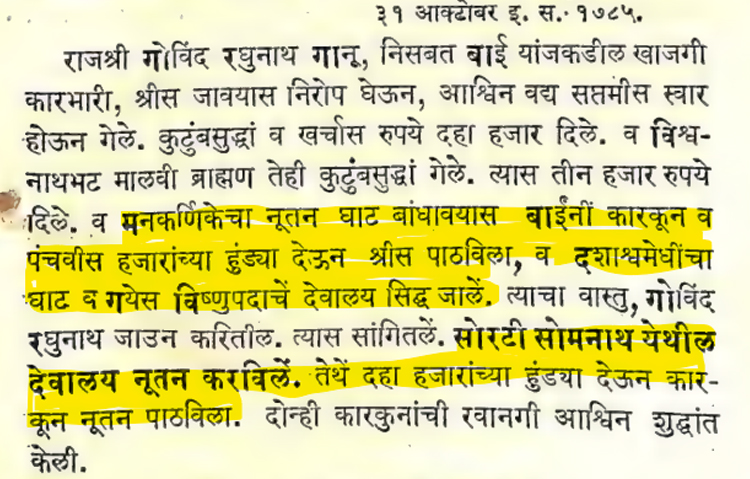
Translation: Letter
written in October 1785 describing various charitable activities undertaken by Maharani
Ahilyabai Holkar. Govind Raghunath will be sent to Vishnupad Mandir at Gaya for
the inauguration of temple. Another scribe was sent to Somnath with Rs 10,000
for the annual expenses of the temple. Ref: Devi Ahilyabadi Charitra by V.N.Deo
(303) (Credit-author)
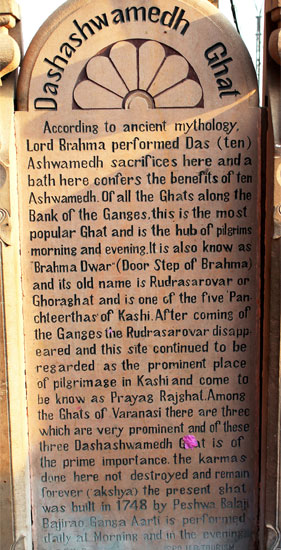 Made in 1748 by Peshwa Balaji Bajirao.
Made in 1748 by Peshwa Balaji Bajirao.
Various Ghats and
the temples on the banks of the sacred Ganga in Kashi were built/rebuilt during
the 18th century. These invariably have a Maharashtra link for e.g. Dashashwamedh
Ghat (Peshwa Nanasaheb), Bhosale Ghat. Scindia Ghat (built by the respective
nobles), Manikarnika Ghat (repaired by Devi Ahilyabai) Bajirao Ghat and Bhaironath
temple (Peshwa Bajirao II).
Also
read
How the Marathas
shaped Varanasi
11. Vishnupad
(Gaya, Bihar)
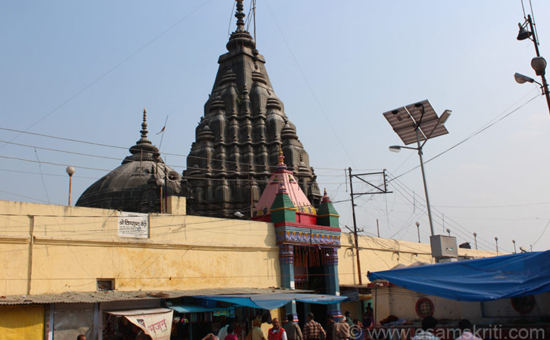
According to Hindu
tradition Gaya is the place where Gayasura was pinned by Shri Vishnu under his
feet. The imprint of his foot on a stone slab became known as Vishnupad. The original
temple on the banks of Phalgu River was demolished during Mughal reign. As confirmed
in the letter given above, the current Vishnuad temple was built by Devi
Ahilyabai Hokar in 1785.
12. Kedarnath
(Uttarakhand)
It is one of 12 jyotirlingas of Mahadev situated in Uttarakhand. For the devotees coming to Kedarnath, Ahilyabai had built a Dharmshala (rest house) and a water tank for drinking water. (Dev-304)
13.
Ganesha Temple in Thanjavur, Tamil Nadu
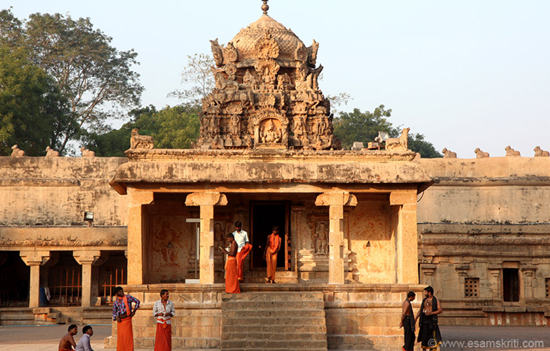 Maratha King Sarabhoji II renovated the entire
shrine and the front mandapa was his own addition.
Maratha King Sarabhoji II renovated the entire
shrine and the front mandapa was his own addition.
The area which
Marathas dominated militarily was one thing but in other parts, they had
established friendly relations with the local powers to ensure the smooth
functioning of temples and charitable institutions which they patronized.
The history
of Maratha contribution to the revival of dharma, by re-constructing temples and tirthas across India, needs to be
known to more people.
Marathas helped
develop the whole ecosystem from priests to artisans, masons to the persons
providing facilities to pilgrims, literature to arts and crafts. The stability,
safety, and peace that Marathas provided were instrumental in the restoration
of the freedom of worship from 17th to 19th century.
To read all
articles by author
To read all
articles on Maratha History
To read all
articles on Indian History
References
1. Aurangzeb- Whitewashing Tyrant, Distorting Narrative by the author.
2. Temples and legends of Maharashtra- M.S. Mate.
3. Shivchartira Sahitya-Volume 2.
4. Purabhilekh Puratatva -Volume 2-ASI, Goa Unit.
5. Portuguese-Maratha Relations- Dr. P.S.Pissurlencar.
6. Varshik Itivritta-1916- Bharat Itihas Sanshodhak Mandal.
7. Sanads & Letters- D.B. Parasnis & P.V.Mawjee.
8. Somnath The Eternal Shrine- K.M.Munshi.
9. Jagannath Puri & Marathas- P.M. Barik.
10. Ujjain- K.B.Dongray.
11. Orissa under Marathas- B.C.Ray.
12. Devi Ahilyabai Charitra- V.N.Deo.
13. Life & Times of Shivaji II (Chhatrapati Shahu)- M.V.Burway.
14. The sacred city of the Hindus- Rev. M.A. Sherring.
15. Goa Gazetteer-V1.